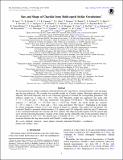| dc.contributor.author | Gulbis, Amanda A. S. | |
| dc.date.accessioned | 2017-11-08T15:41:38Z | |
| dc.date.available | 2017-11-08T15:41:38Z | |
| dc.date.issued | 2017-09 | |
| dc.date.submitted | 2017-08 | |
| dc.identifier.issn | 1538-3881 | |
| dc.identifier.issn | 0004-6256 | |
| dc.identifier.uri | http://hdl.handle.net/1721.1/112139 | |
| dc.description.abstract | We use data from five stellar occultations observed between 2013 and 2016 to constrain Chariklo's size and shape, and the ring reflectivity. We consider four possible models for Chariklo (sphere, Maclaurin spheroid, triaxial ellipsoid, and Jacobi ellipsoid), and we use a Bayesian approach to estimate the corresponding parameters. The spherical model has a radius R = 129 ±3 km. The Maclaurin model has equatorial and polar radii a = b 143 [subscript -6][superscript +3] km and c = 96 [subscript -4][superscript +14] km, respectively, with density 970 [subscript -180][superscript +300] kg m [superscript -3]. The ellipsoidal model has semiaxes a = 148 [subscript -4][superscript +6] km, b = 132[subscript -5][superscript +6] km, and a = c 102 [subscript -8][superscript +10] km. Finally, the Jacobi model has semiaxes a = 157 ±4 km, b = 139 ±4 km, and c = 86 ±1 km, and density 796 [subscript -4] [superscript +2] kg m[superscript -3]. Depending on the model, we obtain topographic features of 6-11 km, typical of Saturn icy satellites with similar size and density. We constrain Chariklo's geometric albedo between 3.1% (sphere) and 4.9% (ellipsoid), while the ring I/F reflectivity is less constrained between 0.6% (Jacobi) and 8.9% (sphere). The ellipsoid model explains both the optical light curve and the long-term photometry variation of the system, giving a plausible value for the geometric albedo of the ring particles of 10%-15%. The derived mass of Chariklo of 6-8 ×10 18 kg places the rings close to 3:1 resonance between the ring mean motion and Chariklo's rotation period. | en_US |
| dc.publisher | IOP Publishing | en_US |
| dc.relation.isversionof | http://dx.doi.org/10.3847/1538-3881/aa8956 | en_US |
| dc.rights | Article is made available in accordance with the publisher's policy and may be subject to US copyright law. Please refer to the publisher's site for terms of use. | en_US |
| dc.source | IOP Publishing | en_US |
| dc.title | Size and Shape of Chariklo from Multi-epoch Stellar Occultations | en_US |
| dc.type | Article | en_US |
| dc.identifier.citation | Leiva, R. et al. “Size and Shape of Chariklo from Multi-Epoch Stellar Occultations.” The Astronomical Journal 154, 4 (September 2017): 159 © 2017 The American Astronomical Society | en_US |
| dc.contributor.department | Massachusetts Institute of Technology. Department of Earth, Atmospheric, and Planetary Sciences | en_US |
| dc.contributor.mitauthor | Sickafoose, Amanda A | |
| dc.relation.journal | Astronomical Journal | en_US |
| dc.eprint.version | Final published version | en_US |
| dc.type.uri | http://purl.org/eprint/type/JournalArticle | en_US |
| eprint.status | http://purl.org/eprint/status/PeerReviewed | en_US |
| dc.date.updated | 2017-11-07T14:28:36Z | |
| dspace.orderedauthors | Leiva, R.; Sicardy, B.; Camargo, J. I. B.; Ortiz, J.-L.; Desmars, J.; Bérard, D.; Lellouch, E.; Meza, E.; Kervella, P.; Snodgrass, C.; Duffard, R.; Morales, N.; Gomes-Júnior, A. R.; Benedetti-Rossi, G.; Vieira-Martins, R.; Braga-Ribas, F.; Assafin, M.; Morgado, B. E.; Colas, F.; De Witt, C.; Sickafoose, A. A.; Breytenbach, H.; Dauvergne, J.-L.; Schoenau, P.; Maquet, L.; Bath, K.-L.; Bode, H.-J.; Cool, A.; Lade, B.; Kerr, S.; Herald, D. | en_US |
| dspace.embargo.terms | N | en_US |
| dc.identifier.orcid | https://orcid.org/0000-0002-9468-7477 | |
| mit.license | PUBLISHER_POLICY | en_US |
